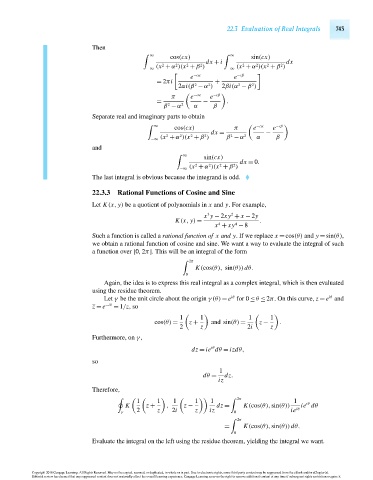Page 763 - Advanced_Engineering_Mathematics o'neil
P. 763
22.3 Evaluation of Real Integrals 743
Then
cos(cx) sin(cx)
∞ ∞
dx + i dx
2
2
2
2
2
2
2
−∞ (x + α )(x + β ) −∞ (x + α )(x + β )
2
e e
−cα −cβ
= 2πi +
2αi(β − α ) 2βi(α − β )
2
2
2
2
π e −cα e −cβ
= − .
β − α 2 α β
2
Separate real and imaginary parts to obtain
∞
cos(cx) π e e
−cα −cβ
dx = −
2
2
2
2
2
−∞ (x + α )(x + β ) β − α 2 α β
and
∞
sin(cx)
dx = 0.
2
−∞ (x + α )(x + β )
2
2
2
The last integral is obvious because the integrand is odd.
22.3.3 Rational Functions of Cosine and Sine
Let K(x, y) be a quotient of polynomials in x and y. For example,
3
2
x y − 2xy + x − 2y
K(x, y) = .
4
x + xy − 8
4
Such a function is called a rational function of x and y. If we replace x = cos(θ) and y = sin(θ),
we obtain a rational function of cosine and sine. We want a way to evaluate the integral of such
a function over [0,2π]. This will be an integral of the form
2π
K(cos(θ), sin(θ))dθ.
0
Again, the idea is to express this real integral as a complex integral, which is then evaluated
using the residue theorem.
iθ
iθ
Let γ be the unit circle about the origin γ(θ) = e for 0 ≤ θ ≤ 2π. On this curve, z = e and
z = e −iθ = 1/z,so
1 1 1 1
cos(θ) = z + and sin(θ) = z − .
2 z 2i z
Furthermore, on γ ,
iθ
dz = ie dθ = izdθ,
so
1
dθ = dz.
iz
Therefore,
1 1 1 1 1 1
2π
iθ
K z + , z − dz = K(cos(θ),sin(θ)) ie dθ
2 z 2i z iz ie iθ
γ 0
2π
= K(cos(θ),sin(θ))dθ.
0
Evaluate the integral on the left using the residue theorem, yielding the integral we want.
Copyright 2010 Cengage Learning. All Rights Reserved. May not be copied, scanned, or duplicated, in whole or in part. Due to electronic rights, some third party content may be suppressed from the eBook and/or eChapter(s).
Editorial review has deemed that any suppressed content does not materially affect the overall learning experience. Cengage Learning reserves the right to remove additional content at any time if subsequent rights restrictions require it.
October 14, 2010 15:37 THM/NEIL Page-743 27410_22_ch22_p729-750

